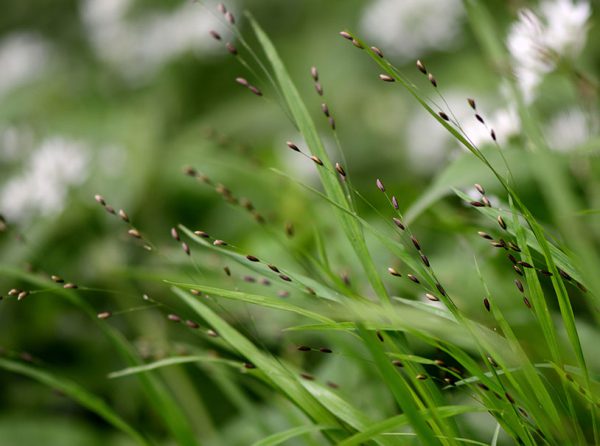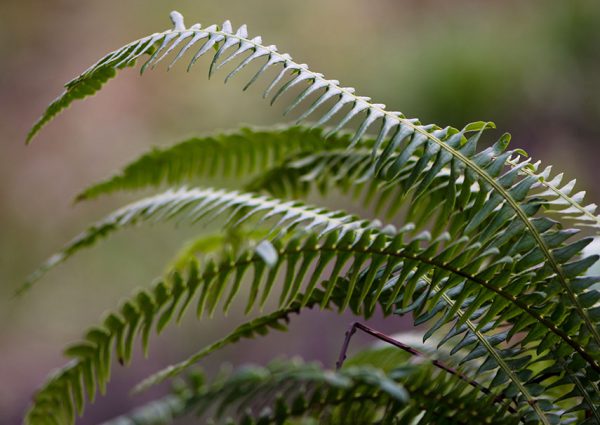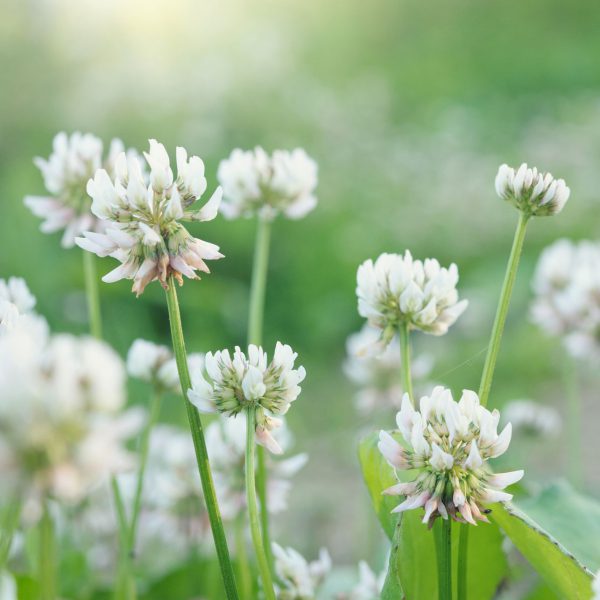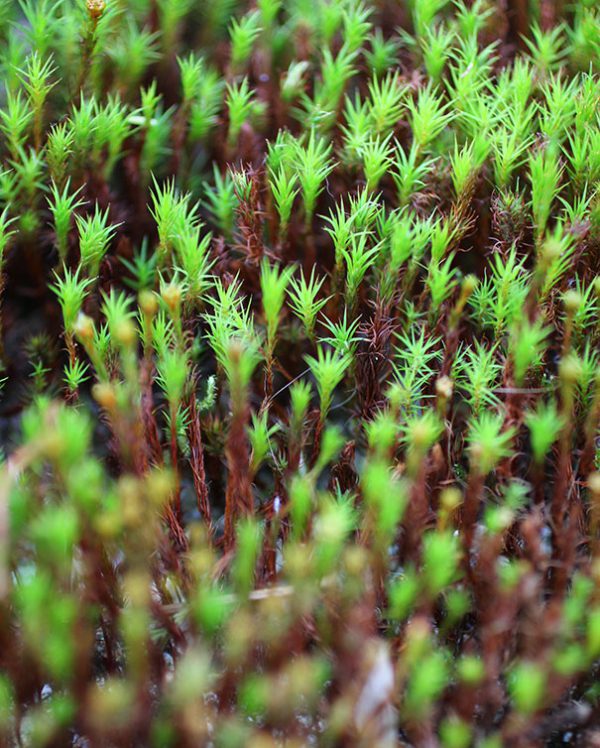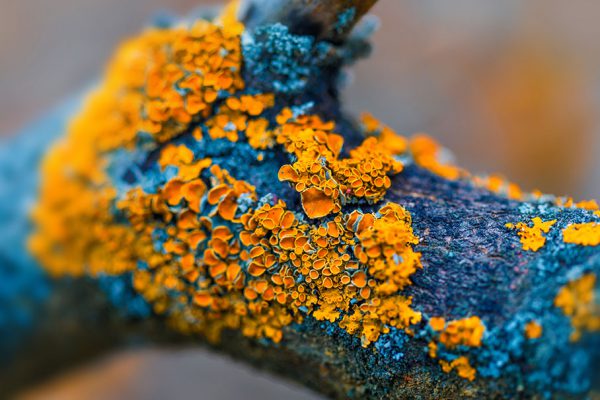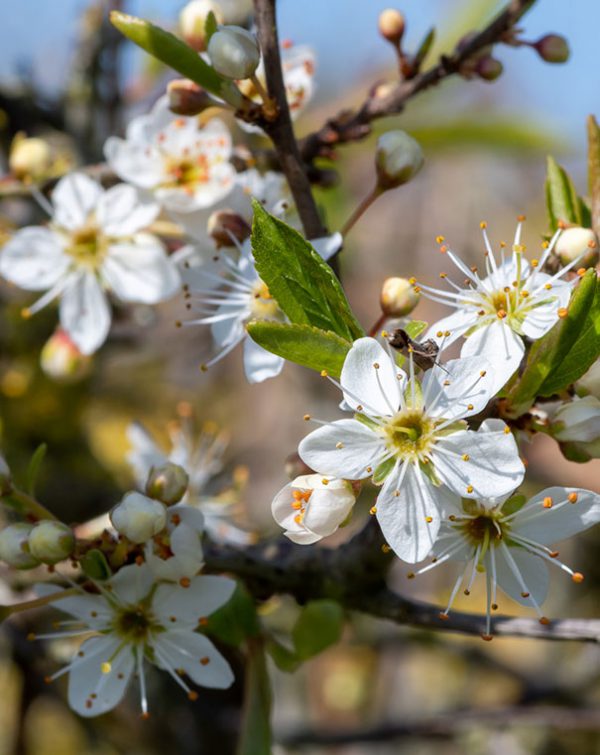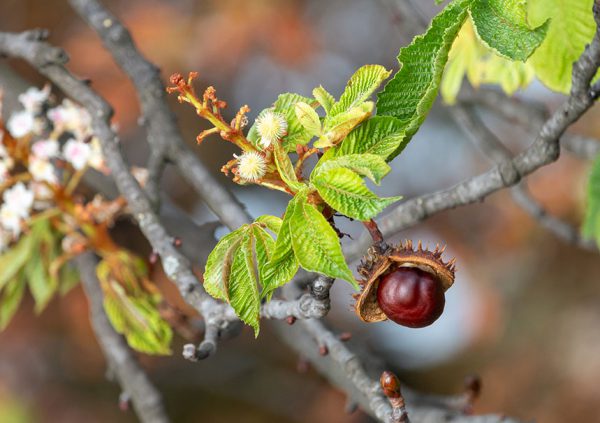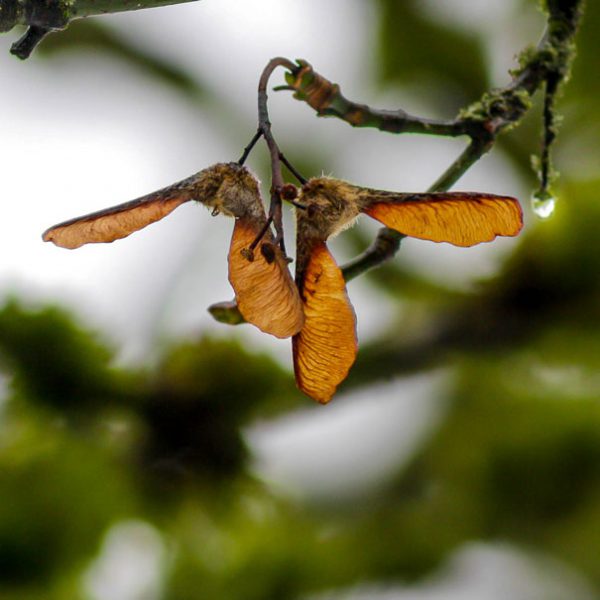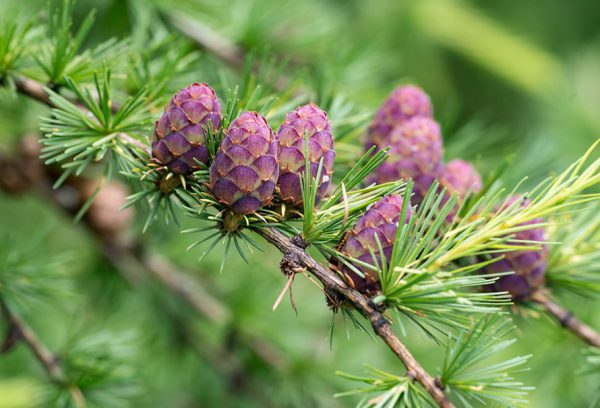Nature
The Commons provide a diverse range of habitats from heathland and woodland to semi-natural ponds, resulting in an enormously diverse and surprising range of plants and animals.
Animals
Common frog, grass snake, robin, roe deer or sparrowhawk; what will you find while exploring the Commons today?
Don’t forget we’d love to see your photographs.
-
Birds
For many years the Commons have been noted as a good spot for bird watching, bearing in mind their urban location and relatively small size. In the early 1960s local ornithologist Harold Betteridge listed 36 species nesting on the Commons and made a photographic record of their nests. Nowadays, around 40 resident species can be found, along with about 15 summer or winter visitors.
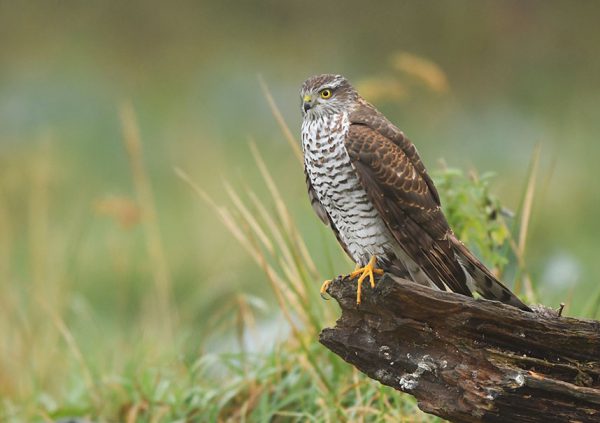
Sparrow Hawk
Birds of prey
Among the birds of prey, kestrels, (falco tinnunculus) sparrow hawks, (accipiter nisus) buzzards (buteo buteo) and red kites (miles milvus) have been observed on the Commons. The ‘little owl’ (athene noctua), ‘tawny owl’ (strix aluco) and ‘long-eared owl’ (asio otus) also have also been recorded.
Crows family
The large numbers of magpies (pica pica) cannot fail to be observed, and their relatives the ‘carrion crow’ (corvus corone), jackdaw (corvus monedula) and jay (garrulus glandarius) are also to be found.
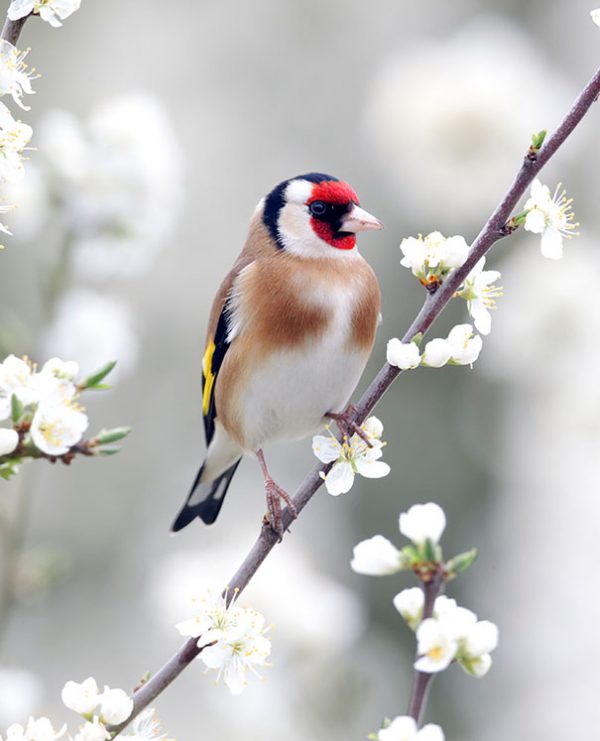
Goldfinch
Finches
Familiar also are the chaffinch (fringilla coelebs), as well as more elusive relatives like the bullfinch (pyrrhula pyrrhula), hawfinch (coccothraustes coccothraustes), linnet (linaria cannabina) and ‘lesser redpoll’ (acanthis cabaret). Groups of the colourful goldfinch (carduelis carduelis) may be observed on occasions feeding at thistle seeds in large stands such as that beneath Mount Edgcumbe Rocks.
Robins & wrens
Birds such as the robin (erithacus rubecula) and wren (troglodytes troglodytes) may also readily be seen.
Swallows & martins
Swallows (hirundo rustica) and ‘house martins’ (delichon urbicum) are to be seen hunting insects over open ground such as that between Victoria Grove and Wellington Rocks.
The warblers
Among the summer visitors are the ‘willow warbler’ (phylloscopus trochilus), ‘wood warbler’ (phylloscopus sibilatrix), ‘garden warbler’ (sylvia borin) and blackcap (sylvia atricapilla).
Thrushes
The ‘song thrush’ (turdus philomelos) finds abundant snails of various species on the Commons, and its characteristic ‘anvils’, stones arising from bare ground and surrounded by shell fragments, can often be spotted along footpaths. The ‘mistle thrush’ (turdus viscivorus) is also resident.
Winter visitors include the fieldfare (turdus pilaris) and the redwing (turdus iliacus).
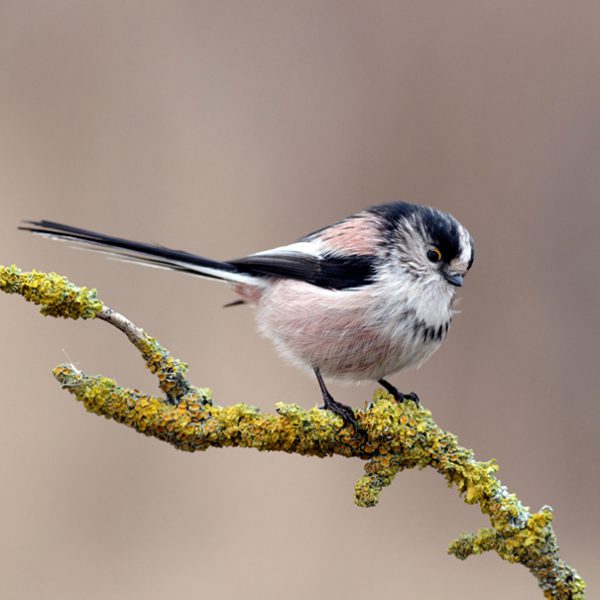
Long Tailed Tit
Tits & crests
Familiar garden birds such as ‘blue tit’ (cyanistes caeruleus) and ‘great tit’ (parus major) may readily be seen, and there are also records of more elusive relatives like goldcrest (regulus regulus). One of the most characteristic of the resident species is the ‘long-tailed tit’ (aegithalos caudatus), often seen in small flocks moving from tree to tree; its elaborate nests of moss, spider webs and hair, covered with lichen, are constructed in gorse bushes.
Water birds
Few water birds occur on the Commons, but mallard (anas platyrhynchos) and moorhen (gallinula chloropus) may be seen at Brighton Lake, and a kingfisher (alcedo atthis) has also been seen.
Woodland birds
The nuthatch (sitta europaea) and treecreeper (certhia familiaris) inhabit the various wooded areas, where the occasional pheasant (phasianus colchicus) has also been seen. Nightingales (luscinia megarhynchos) have been confirmed as nesting on Tunbridge Wells Common in the past, and adult birds continue to be reported.
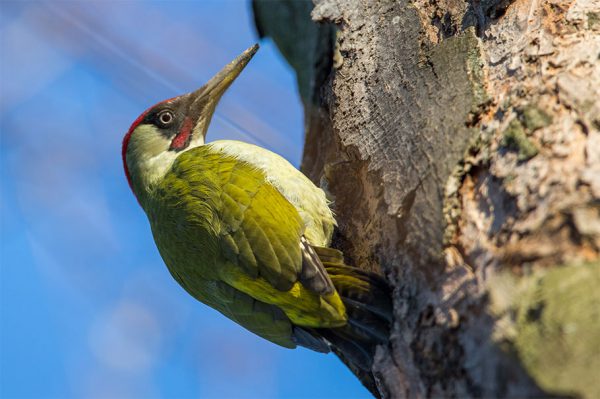
Green Woodpecker
Woodpeckers
All three British species of woodpecker are to be found on the Commons, although the ‘great spotted woodpecker’ (dendrocopos major) and ‘lesser spotted woodpecker’ (dryobates minor) are much less conspicuous than the ‘green woodpecker’ (picus viridis). The latter has been noted feeding at anthills in the grassland near Wellington Rocks.
Others
Summer visitors include the ubiquitous cuckoo (cuculus canorus), generally heard rather than seen, as well as the ‘spotted flycatcher’ (muscicapa striata), and chiffchaff (phylloscopus collybita).
-
Fish
Fish occur only in Brighton Lake, where they must have been introduced, as this pond was only created in 1858. However, they undoubtedly flourish there, and some surprisingly large specimens are evident. The population of sizable ‘common carp’ (cyprinus carpio) is the most conspicuous, but perch (perca fluviatilis), tench (tinca tinca), roach (rutilus rutilus) and rudd (scardinius erythrophthalmus) are also present. A small pike (esox lucius) was recorded recently. Sticklebacks (gasterosteus aculaeatus) are also to be found.
-
Insects & Invertebrates
-
Bees, Wasp & Ants
There are about 120,000 different species in the order of hymenoptera – bees, wasps, ants.
Holes and burrows in the ground
Walkers on the Commons in high summer will undoubtedly have seen clusters of small holes in the sandy ground of footpaths and around rocks and may well have spotted insects of various sizes and colours, looking vaguely like bees and wasps, going in and out of them. The more observant may have noticed similar burrows in south-facing drainage ditches, root plates or banks with sparse vegetation from early spring onwards.
These small tunnels are the nests of solitary bees and wasps, an often overlooked but important element of the Commons’ fauna. The sandy soil and rock outcrops of the Commons are ideal for these creatures, and many otherwise rare varieties find a refuge here. Over 130 species have so far been recorded for the Commons, including eighteen on the official national list of scarce and endangered species.
Solitary and social bees and wasps
‘Solitary’ bees and wasps are to be distinguished from their ‘social’ relatives which live in communities with a breeding queen and sterile workers. Although solitary species often nest in proximity, congregating in particularly favoured spots, each female digs its own individual burrow and stocks it with suitable food for its offspring.
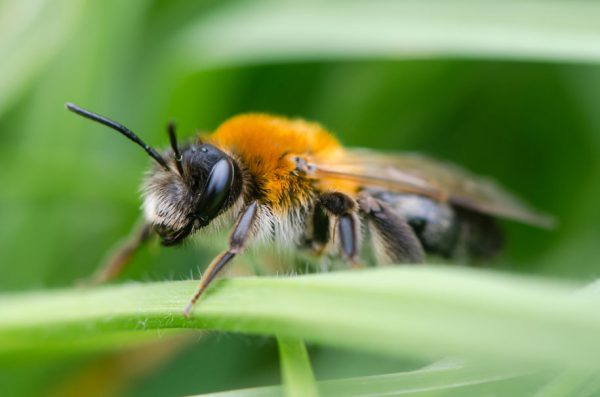
Tawny Mining Bee
Mining bees
The seasonally earliest species to appear are the ‘mining bees’ (andrena), some of which can be active as early as late February while most are at their peak in March and April. The females dig burrows in bare or sparsely vegetated ground, which they stock with honey and pollen before laying their eggs. They are especially fond of south-facing areas such as Terrace Walk, at the back of Brighton Lake, and Happy Valley. Wellington Rocks and the rocks at Denny Bottom are also favoured sites.
Mining bees are very diverse in size and colour, the largest being about the size of a honeybee, while the smallest are not much bigger than a large ant.
The most spectacular, the ‘tawny mining bee’ (andrena fulva) has bright orange fur on its hind body, while the thorax is deep scarlet. Other species frequently observed in spring include the ‘early mining bee’ (andrena haemorrhoa), which has a golden tip to its body, the ‘yellow-legged mining bee’ (andrena flavipes), which has a golden pollen basket and pale brown bands, and the very early flying ‘Clark’s mining bee’ (andrena clarkella), with black fur behind and red in front.
Among the few which fly in summer is the ‘white-banded mining bee’ (colletes succinctus), always seen visiting heather.
Female mining bees
Female mining bees are generally more distinctive than males, but the light grey males of the ‘bearded mining bee’ (andrena barbilabris) often make themselves conspicuous by flying low over areas of bare sand.
Laying in a store of food for their offspring entails numerous visits to and from nearby flowers, so the females can often be seen entering their tunnels carrying clumps of brightly coloured pollen in the baskets of hairs on their hind legs.
Female mining bees often make great efforts to conceal their nests from predators, carefully opening and sealing them as they travel to and fro with supplies. However, this does not protect them from the cuckoo bees whose females are highly skilled in detecting other bees’ burrows so that they can lay their own eggs inside and save themselves the trouble of gathering their own stores of food.
Mining-bee cuckoos
Every species of mining bee has a specialist cuckoo-bee species which is attached to it, roaming around its nesting sites in search of opportunities. The smaller mining bees have associated cuckoos of the genus sphecodes, which are red and black in colour, but the larger varieties are parasitised by the more conspicuous ‘nomad bees’.
The nomad bees, which can often be seen in spring exploring the areas where mining bees congregate, have a close resemblance to wasps. One of the commonest, the ‘red-horned nomad’ (nomada flava), has yellow, black and brown bands, and three vertical red stripes on the thorax. The body of the larger ‘six-banded nomad’ (nomada fulvicornis), one of the Commons’ rarities, is patterned entirely in yellow and black.
Mason bees
Later in the year, the mining bees are joined by various smaller groups, some of which make their nests in rotten wood. The ‘red mason bee’ (osmia bicornis) has light orange fur on its abdomen, while the ‘blue mason bee’ (osmia caerulescens) is of a dark metallic colour.
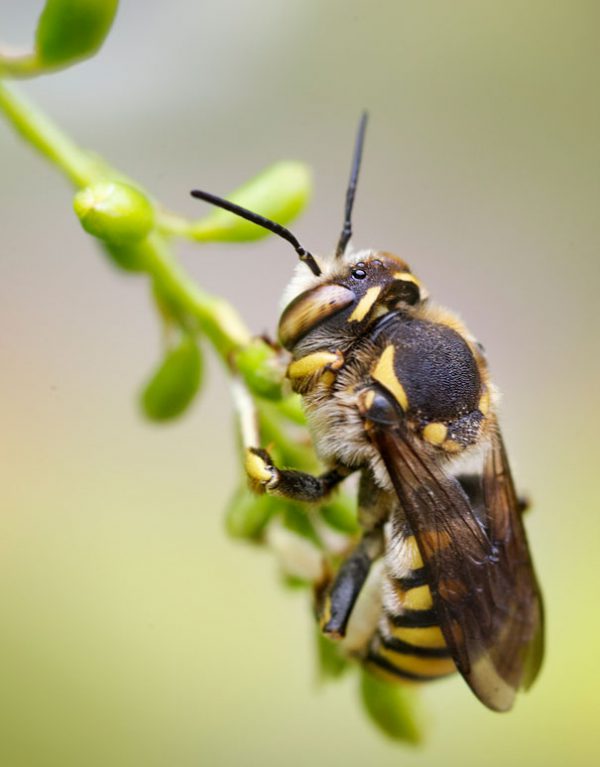
Leafcutter Bee
Leaf-cutter bees
The females of the Commons’ three species of ‘leaf-cutter bees’ (megachile species pluralis) use their powerful jaws to cut semi-circular pieces out of leaves. They use these to make a series of individual cells in their burrows, filling them with honey and pollen for their young. The pieces of leaf are folded into a cylinder, with smaller round portions serving as a base and lid. Female leafcutters have a rather flattened body with a brush of coloured hairs underneath for carrying pollen.
Flower bee companions to the leaf-cutter bee
Anthophora are one of the largest families of solitary types of bee. The scarce flower four-banded bee ‘anthophora quadrimaculata’, which resembles a small brown bumblebee with a swift darting flight, is exclusively devoted to flowers of the labiate family (flowers with lip or liplike parts), which it visits in company with the larger orange fork-tailed ‘anthophora furcata’ and the yellow-spotted ‘wool-carder bee’ (anthidium manicatum), a genus of the leaf-cutter bee.
Solitary wasps
Solitary wasps do not generally become active until June or later. Many species nest in similar locations to those favoured by mining bees, while others burrow into dead wood and can be found exploring sunlit timber. In contrast to the bees, these wasps provide live food for their young. The largest group, the ‘digger wasps’ show a wide range of size and colour pattern, some having the typical wasp pattern of yellow and black stripes, while other species are red and black, or all black. The nesting females capture flies, beetles, caterpillars or other insects, according to the preference of each species. They prepare their captures for use by the expedient of paralysing them with their sting, so that the victims remain fresh but unable to escape from the burrow while the wasp larva hatches from its egg and begins to devour them.
Among the more conspicuous ground-nesting species, with substantial colonies around Wellington Rocks and Toad Rock, are the yellow and black ‘sand tailed digger wasp’ (cerceris arenaria), which hunts for weevils, and the red and black ‘astata boops’, whose prey is shield-bug nymphs.
Spider-hunting wasps
The ‘spider-hunting wasps’ (pompilidae), red and black or all black in colour, have similar habits to the digger wasps, but specialise in the capture of spiders. They are agile and fast-moving insects which run rather than fly as they seek out their prey.
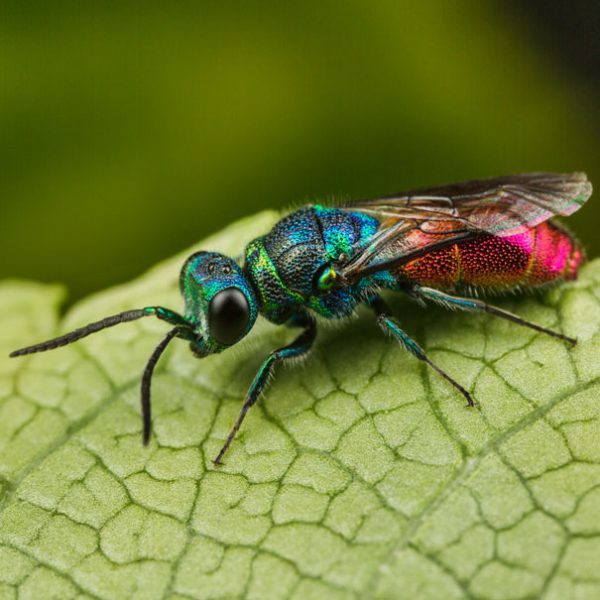
Ruby Tailed Wasp
Cuckoo wasps
As with solitary bees, the digger wasps and spider-hunting wasps have their associated cuckoo species which intrude into their stocked nests and lay their eggs there. These parasites include several species of ‘ruby-tailed wasps’ (chrysis ignita), which are among the most attractive and exotic-looking of British insects. They are active only in bright sunshine and are brilliantly metallic, coloured in various combinations of green, ruby red and deep blue. The most beautiful of all, ‘chrysis viridula’, is most often seen on Rusthall Common, exploring the nesting sites of its host, the ‘spiny mason wasp’ (odynerus spinipes), which is distinctive in its own right by reason of the curious curved mud chimneys which it constructs over the entrance to its burrows in bare vertical sandy surfaces.
Social bees and wasps
Although numerically abundant, social bees and wasps are much fewer in the number of their species than their solitary cousins.
Like all insects that live in colonies, each species is divided into three castes: queens, males and workers. The queens are the fertile females and founders of the colony, surviving the winter by hibernation and emerging as early as possible in the new year to establish their nests, either in holes in the ground or in dense vegetation. The nest consists of a ball of dried grass or moss, in the centre of which the female builds wax cells for her eggs along with containers for storing food. Her first offspring are workers, sterile females which assist in the development of the colony and take over the work of gathering nectar and pollen.
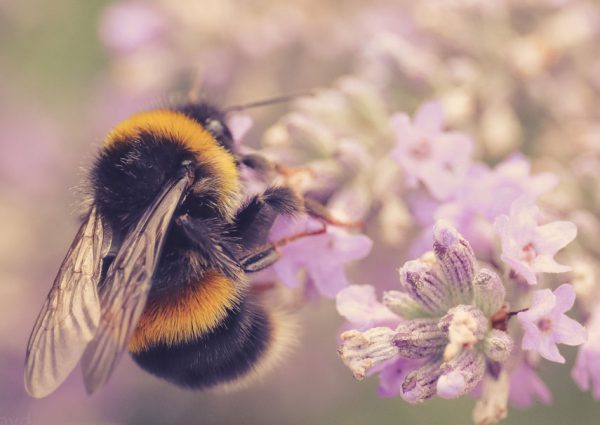
Buff Tailed Bumblebee
Bumblebees
On the Commons, the most widespread of the social bees are six species of bumblebees, whose furry coat enables them to fly in cold, dull or rainy weather when most other insects are immobilised. The ‘buff-tailed bumblebee’ (bombus terrestris), ‘white-tailed bumblebee’ (bombus lucorum), ‘garden bumblebee’ (bombus hortorum), ‘early bumblebee’ (bombus pratorum) and ‘red-tailed bumblebee’ (bombus lapidaries) are all familiar visitors to flowers on the Commons, as is the distinctive brown ‘common carder bee’ (bombus pascuorum). Lone queens seen flying low in the early months of the year are engaged in their search for suitable nest sites.
Honeybees
Honeybees (apis) are regularly seen on the Commons too, but these are visitors from domestic hives.
Social wasps
Social wasps recorded on the Commons comprise the two familiar urban species the ‘common wasp’ (vespula vulgaris) and the ‘German yellowjacket’ (vespula germanica), along with the ‘tree wasp’ (dolichovespula sylvestris) and two related species which have recently colonised southern Britain from the Continent, the ‘median wasp’ (dolichovespula media) and the ‘Saxon wasp’ (dolichovespula saxonica).
Ants
Ants are social insects found on the Commons, one of which contributes to the landscape in the form of the prominent earthen mounds to be seen in areas of acid grassland, such as around Highbury. These are constructed by the ‘yellow meadow ant’ (lasius flavus) and may be many decades old. The ants themselves remain below the surface and are unlikely to be seen unless one of their nests is disturbed. Sections of these old nest mounds are sometimes occupied by colonies of the ‘brown ant’ (myrmica scabrinodis). Unlike the meadow ant, this and its relative the ‘common red ant’ (myrmica ruginodis) are usually seen actively foraging, often high up on grassland vegetation.
Most widespread of all, found both in open spots and in woodland, are the subterranean nesting ‘garden black ant’ (lasius niger), and the larger long-legged relative ‘black ant’ (formica fusca). It is the winged females of these latter two species that are most likely to be noticed by the general public on hot days in high summer, as swarms of ‘flying ants’. These are newly emerged queens engaged, along with the much smaller males, in their annual synchronised courtship flight, after which they shed their wings to retreat underground as founders of new colonies.
-
Beetles
Numerous types of beetles (coleoptera) occur on the Commons. Although the majority are modest creatures, there are some whose size or colour may bring themselves to the attention of the public. The majority of the fast-moving predatory ground beetles are nocturnal, but several ‘metallic’ species make themselves visible by running across sunlit paths. The related ‘green tiger beetle’ (cicindela campestris), a brightly coloured species that flies readily in hot weather, is sometimes seen in similar situations.
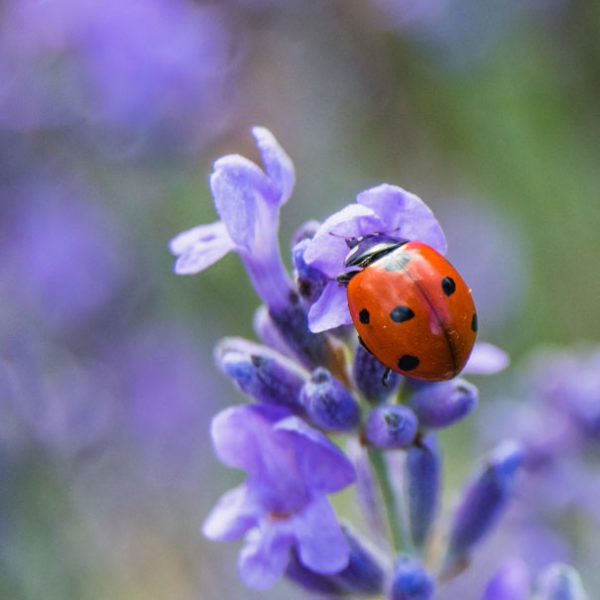
Seven-spot Ladybird
Ladybirds
The ladybirds, whose bright colours advertise them as distasteful to birds, are also predators, feeding on aphids. Such species as the very common ‘seven-spot ladybird’ (coccinella septempunctata) and smaller ‘two-spot ladybird’ (adalia bipunctata) hibernate as adults but are much in evidence on sunny days in winter.
Aquatic predators
Aquatic predators include the impressive ‘great giving beetle’ (dytiscus marginalis), found with many related forms in the various ponds on the Commons.
Leaf beetle
Many beetles feed on plant foliage, keeping themselves well hidden, but some of the ‘leaf beetles’ (chrysomelidae) are brightly coloured, as are the metallic ‘green leaf weevils’ (phyllobius) found on various trees and low-growing plants. The colour-variable ‘reed beetle’ (plateumaris sericea), found on emergent vegetation at the fringes of ponds, may be bronze, copper, deep blue or purple in colour.
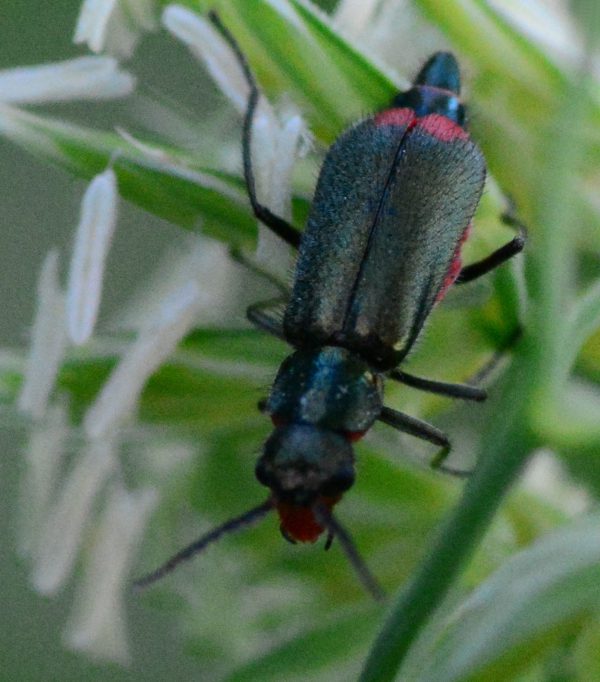
Malachite Beetle
Flower-eating beetles
Of the beetles which feed actively at flowers, the most abundant is the ‘common soldier beetle’ (rhagonycha fulva) orange with black tips, a characteristic of insects in the middle of summer.
Several related species occur in smaller numbers, all being particularly fond of the tall flower heads of umbellifers (with their clustered heads of tiny flowers), thistles and ragwort. The red-tipped ‘malachite beetle’ (malachius bipustulatus) and the slender ‘false oil beetle’ (oedemera nobilis) both metallic-green are more likely to be seen on low-growing flowers such as buttercups. The brilliant reflective scarlet of the Commons’ two species of ‘cardinal beetle’, the ‘black-headed cardinal beetle’ (pyrochroa coccinea) and ‘red-headed cardinal beetle’ (pyrochroa serraticornis), are very noticeable, whether they are visiting flowers, sitting on foliage or in flight.
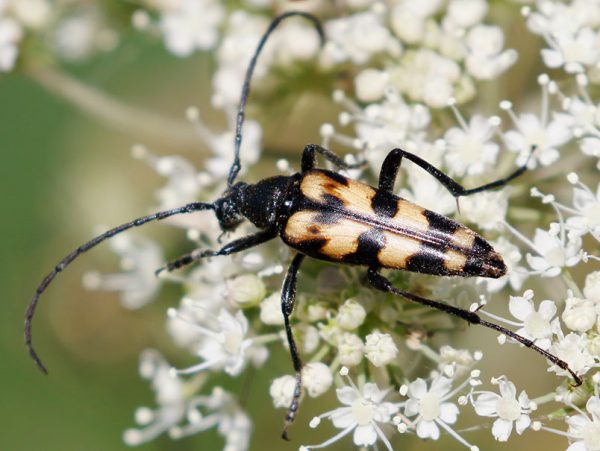
Spotted Longhorn Beetle
Longhorn beetles
Many of the longhorn beetles, noted for their long antennae, are strikingly coloured or patterned, flying on sunny days and feeding at brambles and other flowers. They include the yellow and black ‘wasp beetle’ (clytus arietis) and ‘spotted longhorn’ (strangalia maculate), and two larger orange and black species, the ‘longhorn beetle’ (strangalia quadrifasciata) and the rare and impressive ‘golden haired’ (leptura aurulenta).
Rove beetles
‘Rove beetles’ (staphylinidae), characterized by their short wing cases exposing most of the abdomen, are abundant inhabitants of the Commons, although most species are small and do not attract attention. Only the large black, so-called ‘devil’s coach-horse’ (staphylinus olens) running over sunlit footpaths, is likely to be noticed by the general public.
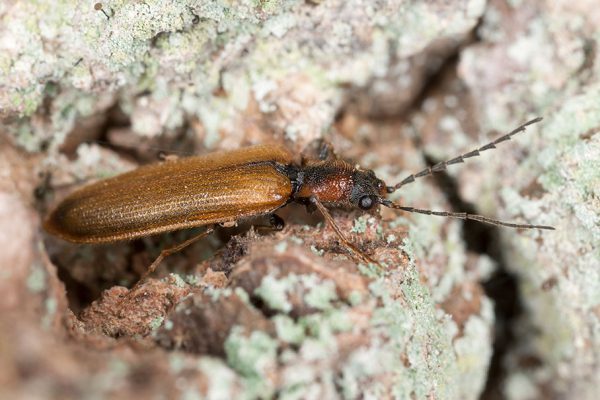 Click beetles
Click beetles‘Click beetles’ (elateridae), slender insects able to flip themselves into the correct position after falling on their back, are also numerous, and the common athous haemorrhoidalis actively flies by day. The large mottled agrypnus murinus is another notable member of the same family.
Scarab beetles
Members of the ‘scarab group’ (scarabaeidae) found on the Commons include the familiar ‘cockchafer or may-bug’ (melolontha melolontha), which is nocturnal and attracted to light, the ‘minotaur beetle’ (typhaeus typhoeus), a dung-beetle with three horns in the male, and the ‘lesser stag beetle’ (dorcus parallelipipedus).
-
Bugs
The extensive order of bugs (hemiptera) is divided into two main sections:
- the ‘true bugs’ (heteroptera)
- related forms of homoptera:
- the aphids (sternorrhyncha)
- the ‘leafhoppers and froghoppers’ (auchenorrhyncha)
- the ‘moss bugs’ (Coleorrhyncha)
An often-overlooked group of insects, many species of bugs are found in grassland and woodland on the Commons.
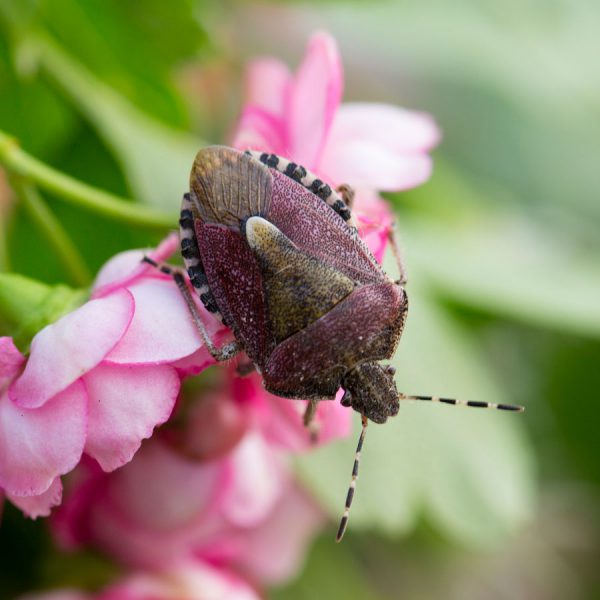
Hawthorn Sheild Bug
True bugs
Among the largest of the ‘true bugs’ found on the Commons are the ‘shield bugs’ (pentatomoidea), including the common ‘green shield bug’ (palomena prasine), often seen on bramble foliage, and the attractive green and purple ‘hawthorn shield bug’ (acanthosoma haemorrhoidale) and ‘birch shield bug’ (elasmostethus interstinctus). The large brown ‘squash bug’ (coreus marginatus) is also easy to spot, as it sits openly on dock leaves. Aquatic members of the ‘heteroptera’ include the ‘common backswimmer’ (notonecta glauca) and the familiar ‘pond-skaters’ or ‘water striders’ (gerris plural species) which live on the surface film of ponds.
Homoptera
The homoptera are mostly small insects which attract little attention, although the nymphs (immature form) of ‘froghoppers’ make themselves conspicuous by producing protective ‘cuckoo spit’ (white frothy liquid secreted by the nymphs), and some ‘aphids’ feed in large clusters which are attended by ants in search of honeydew. Some of the larger and more colourful ‘leafhoppers’ may also be noticed by the general public, for example the bright ‘green leafhopper’ (cicadella viridis) which frequents the damp grassland around ponds.
-
Butterflies & Moths
The most noticeable and widespread members of the Commons’ insect fauna are the butterflies (lepidoptera), of which twenty-five species have been recorded to date on the Commons. (Note lepidoptera also includes the moths.) Some are permanent residents, somewhat inactive species with old established colonies breeding on site generation after generation, while other more mobile species are regular or occasional visitors.
Where butterflies can most be seen on the Commons
The majority of the permanent residents are species typically found on open grassland and heathland, and at their appropriate season most of them can be seen in areas on Tunbridge Wells Common (the acid grassland along Mount Ephraim; overlooking London Road; vicinity of Gibraltar Cottage and Rocklea ; the north-west corner of the Common; the space between Wellington Rocks and Victoria Grove and on Rusthall Common (Denny Bottom; around the Marl Pits; in front of Rusthall Church).
Such butterflies avoid dense woodland but can be quite numerous along the open fringes of the wider footpaths, like Terrace Walk just to the north of Brighton Lake.
Main butterfly species seen on the Commons
The greatest variety of grassland butterflies is to be seen on the Commons from June to August, with the appearance of five warmth-loving species that produce only a single generation of adults each year, and whose caterpillars feed on grasses:
- From the ‘Skippers’ family:
- Small Skipper and Essex Skipper
- Large Skipper
- From the ‘Browns’ family:
- Meadow Brown, and similar Hedge Brown
- Small Heath
- Brown Argus
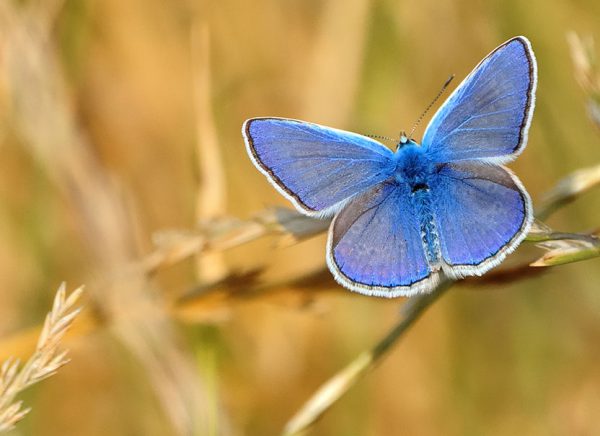
Common Blue
‘Copper’ family of butterflies
The earliest of the grassland species to appear on the Commons is the ‘small copper’ (‘copper’ family; lycaena phlaeas), with its distinctive metallic orange colouration. Emerging in May, it is also one of the latest butterflies to remain on the wing in autumn. The ‘common blue’ (‘blues’ family; polyommatus icarus) also has an early generation, and it too can appear remarkably late in the year.
‘Skippers’ family of butterflies
The ‘small skipper’ (‘skipper’ family: thymelicus sylvestris) and ‘Essex skipper’ (‘skipper’ family: thymelicus lineola) are the most difficult of British butterflies to separate but can be reliably told apart by the tips of their antennae, which are orange underneath for the former and black for the latter. The ‘large skipper’ (‘skipper’ family: ochlodes sylvanus) differs in size, as its name suggests, and has an orange patch on the forewing against a darker background.
‘Hairstreaks’ family of butterflies
The ‘purple hairstreak’ (‘hairstreaks’ family: favonius quercus) is a much more elusive woodland resident, as the adult spends most of its life high in the branches of oak trees, where it feeds on honeydew (sugar-rich sticky liquid, secreted by aphids and some scale insects as they feed on plant sap). Its whole history centres around oaks, the eggs being laid on the leaf buds and the caterpillars feeding on the young foliage in spring. This butterfly is characterized by its metallic purple forewing patches, but it is rarely seen at close quarters.
‘Browns’ family of butterflies
The ‘meadow brown’ (‘browns’ family: maniola jurtina) and the smaller gatekeeper (‘browns’ family: pyronia tithonus) are characterized by small eye spots and light forewing patches on a darker brown background.
Currently much scarcer than any of these is the ‘small heath’ (‘browns’ family: coenonympha pamphilus), a light orange-brown butterfly related to the two browns but considerably smaller. The recently discovered ‘brown argus’ (‘browns’ family: aricia agestis), recorded only twice, is perhaps best interpreted as an elusive resident. A small brown butterfly with orange spots along the edges of its wings, it is easily mistaken for the female of the ‘common blue’, but the latter always has at least some blue scales, if only towards the base of its wings.
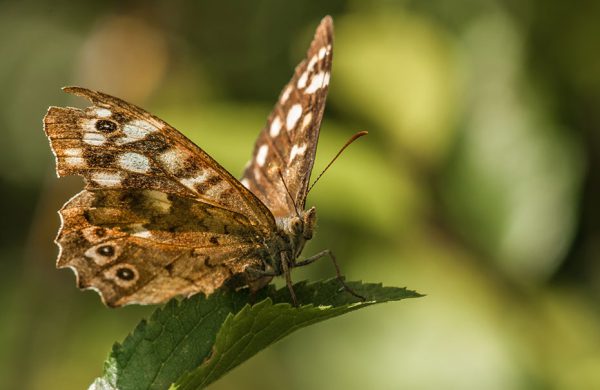
Speckled Wood Butterfly
A common resident with somewhat different habitat preferences is the ‘speckled wood’ (‘browns’ family: pararge aegeria), a distinctive butterfly with cream-white patches on a dark brown background which can be found from as early as April to as late as October. Although it breeds in open spots, its larvae feeding on grasses, the adults tend to frequent shady paths through woodland where the males defend territories consisting of a shifting patch of sunlight.
The ringlet (‘browns’ family: phantopus hyperantus), a blackish brown butterfly with distinctive cream-coloured rings on its underside, was first recorded on the Commons in the mid-1990s and may well become a permanent resident. It is most likely to be seen in summer near brambles along rides and woodland edges.
‘Whites and yellows’ family of butterflies
Late April sees the emergence of the distinctive ‘orange-tip’ (‘whites and yellows’ family: anthocharis cardamines), whose bright orange eggs are surprisingly easy to spot on their main foodplant, garlic mustard. Only the males have orange-tipped forewings, the females being mainly white, but sharing the same mottled-green hindwing underside pattern. In flight, female ‘orange-tips’ closely resemble the green-veined white, but when settled the latter’s grey-green veins on the underside of a light yellowish hindwing are distinctive enough. Unlike the orange-tip, which has only a single spring generation, the ‘green-veined white’ (‘whites and yellows’ family: pieris napi) can be found throughout the year
The lemon-yellow males of the brimstone (‘whites and yellows’ family: gonepteryx rhamniare) are a familiar sight on the Commons in early spring. They hibernate as adults and generally appear at the same time as the small tortoiseshell, peacock and comma, ranging over a wide area. The ‘large white’ (‘whites and yellows’ family: pieris brassicae) and ‘small white’ (‘whites and yellows’ family: pieris rapae) are also highly mobile species, their British populations regularly augmented by migration across the Channel. Both are frequently seen on the Commons, and the latter may sometimes breed there on wild members of the cabbage (brassica) family, such as ‘wild rocket’ (diplotaxis tenuifolia) and watercress (nasturtium officinale).
‘Blues’ family of butterflies
Also present from spring to autumn is the ‘holly blue’ (‘blues’ family: celastrina argiolus), whose plain silver-white underside with a few black specks is the most obvious feature, distinguishing it from the ‘common blue’. Its larvae feed on holly and ivy, and examples are generally seen along rides and woodland edges where its foodplants grow, rather than in the open areas frequented by its relative.
Nymphalids family of butterflies
There are several more mobile butterflies which regularly breed on the Commons and can be counted as residents, although they are active over a wider area, and individuals move in and out from urban parks and gardens and the adjacent countryside. One familiar group of three species, whose larvae feed on nettles, are among the first butterflies to appear in spring; they hibernate as adults on site, concealing themselves in hollow trees and other sheltered spots, from which they emerge on the first warm sunny day of the year.
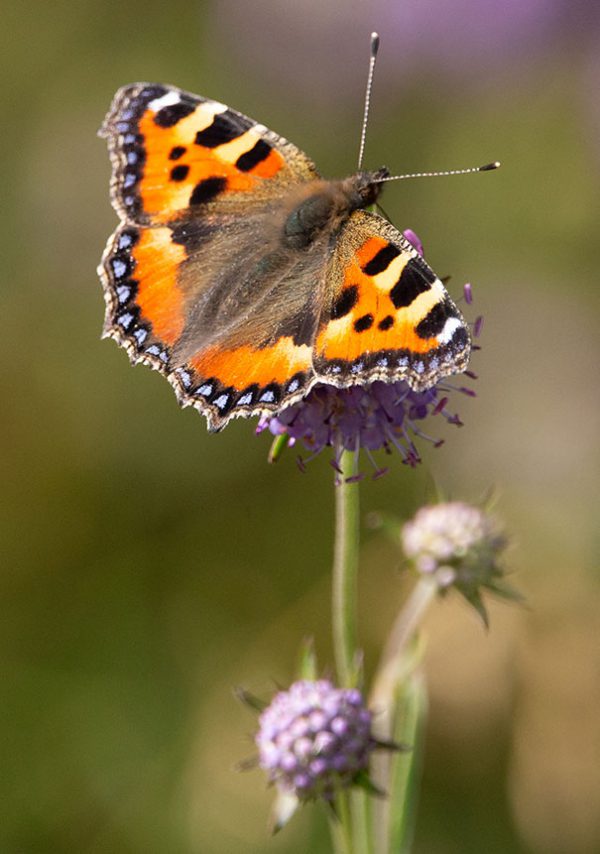
Small Tortoiseshell Butterfly
The bright orange ‘small tortoiseshell’ (‘nymphalids’ family: aglais urticae) and the peacock (‘nymphalids’ family: aglais io) with its multi-coloured eye spots are familiar garden butterflies, but they are equally at home in the wild habitats found on the Commons, particularly in more open areas. The comma (‘nymphalids’ family: polygonia c-album,), an orange-brown butterfly with irregular outlines to its wings, prefers more sheltered spots, favouring wide rides and woodland edges and in the autumn often feeding on ripe fruits like blackberries.
The familiar ‘red admiral’ (‘nymphalids’ family: vanessa atalanta) patterned in white and scarlet on black, is like the small tortoiseshell’ and peacock in its habits; it also breeds on nettles but, as it rarely survives the English winter, it is not a permanent resident. Its population is reinforced each year by migrants. The salmon-pink ‘painted lady’ (‘nymphalids’ family: vanessa carduiis) a much less regular migrant, although in favourable summers it has been recorded on the Commons in considerable numbers.
There are over 2,600 species of moths (lepidoptera).
Day-flying moths
Day-flying moths can often be confused with butterflies (also lepidoptera), and some are surprisingly brightly coloured.
Spring day-flying moths
A characteristically early species is the ‘orange underwing’ (archiearis parthenias – Geometridae), which flies in March and April, sunning itself with outspread wings on the ground in the wider footpaths or feeding at sallow catkins.
May sees the appearance of the ‘small yellow underwing’ (panemeria tenebrata – Noctuidae), a grassland species. The brilliant red and black cinnabar (tyria jacobaeae – Erebidae) is occasionally seen on the Commons, as is its distinctive orange and black striped caterpillar feeding on ragwort.
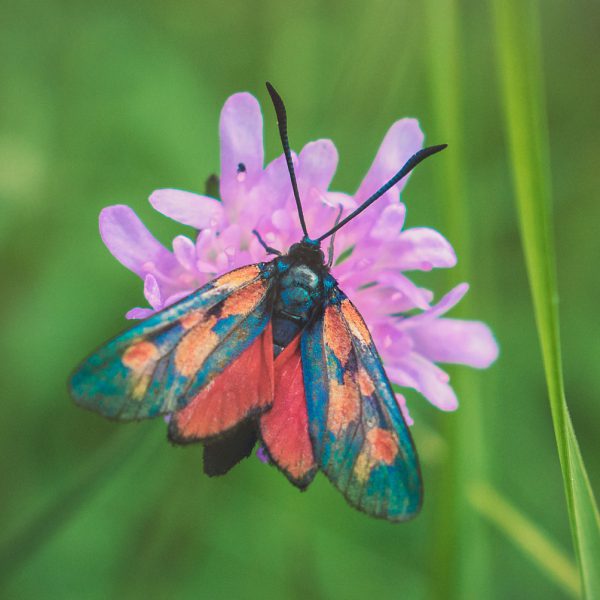
Six Spot Burnet Moth
Summer day-flying moths
In high summer, the ‘six-spot burnet’ (zygaena filipendulae – Zygaenidae) can sometimes be found flying in open grassland on both Commons, together with various butterflies. This moth has a similar colour scheme to the ‘cinnabar’, but it is distinguished by the array of red spots on a forewing that is black with metallic reflections. These patterns are examples of warning colouration, which vertebrate predators learn to associate with creatures that are distasteful.
The ‘silver Y’ (autographa gamma – Noctuidae) is a much duller coloured insect, although its intricate pattern incorporating the metallic mark from which it takes its name is attractive on close inspection. Although sharing the nocturnal flight pattern of most moths, the ‘silver Y’ is often active during the day as well, feeding at heather and other flowers.
The metallic ‘green longhorn’ (adela reaumurella – Adelidae) and its relatives are much smaller insects, but the males with their astonishingly long antennae make themselves conspicuous in spring by flying in dancing swarms around sunlit trees and bushes.
Nocturnal moths
Most of the moths that live and breed on the Commons are purely nocturnal and are therefore rarely or never seen by the general public. However, the use of a light trap at several locations, mainly on Tunbridge Wells Common, on several nights through 1992 produced a list of over one hundred and fifty species. It is certain that further and more regular trapping would increase the list considerably, and it is likely that most of the six hundred or so moth species recorded from Tunbridge Wells in modern times could be found on the Commons.
Noturnal sphingidae moths
Although moths have a reputation for being drab and nondescript insects, they are extremely diverse in colour and pattern, and a number of those recorded from the Commons are visually impressive creatures. Among the largest are the hawk moths, including the delicately patterned green ‘lime hawk’ (mimas tiliae), the ‘poplar hawk’ (laothoe populi), and the brilliantly coloured pink and green ‘elephant hawk’ (deilephila elpenor). The latter takes its name from the resemblance of its caterpillar, found on willow herb, to an elephant’s trunk.
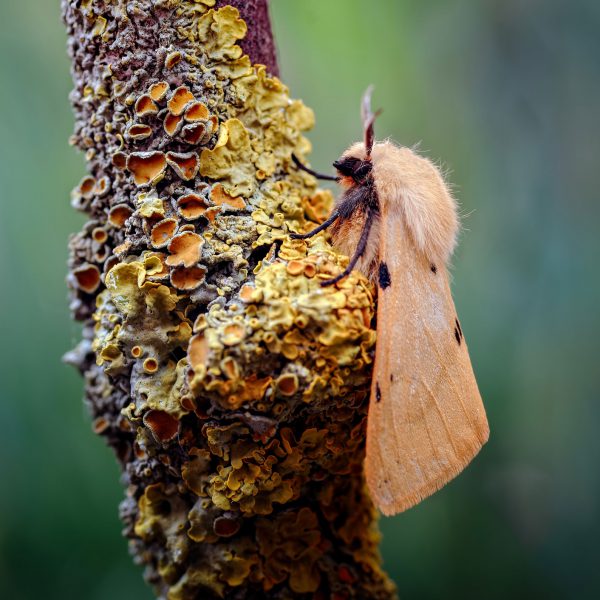
Buff Ermine Macro Moth
Noturnal erebidae moths
As its name suggests, the ‘white ermine’ (spilosoma lubricipeda) is pure white with scattered black spots, while its relative, the ‘buff ermine’ (spilosoma lutea), has a similar pattern but different ground colour.
Noturnal notodontidae moths
The ‘buff-tip’ (phalera bucephala) has a remarkable resemblance to a broken silver birch twig when its wings are folded, while the related ‘swallow prominent’ (pheosia tremula) and ‘lesser swallow prominent’ (pheosia gnoma) have streamlined wings with an elegant white and brown pattern.
Noturnal geometridae moths
The ‘brimstone moth’ (opisthograptis luteolata), with bright yellow wings, shares its name with a butterfly, as does the ‘swallow-tailed moth’ (ourapteryx sambucaria), a large broad-winged insect of a delicate yellowish shade. Of the same grouping is the ‘light emerald moth’ (campaea margaritaria).
Members of other moth groups
Other strikingly coloured species include the ‘peach blossom’ (thyatira batis of Drepanidae) and the bright metallic ‘burnished brass’ (diachrysia chrysitis of Noctuidae).
- From the ‘Skippers’ family:
-
Centipedes & Millipedes
Centipedes and millipedes are myriapods, a branch of the arthropods, exoskeletal-bodied order of animal life, alongside the other significant branch hexapods.
They generally keep themselves out of sight, under stones or fallen timber, although the shiny cylindrical ‘black millipede’ (tachypodoiulus niger) sometimes makes its presence more obvious by climbing the trunks of trees.
The ‘pill millipede’ (glomeris marginate) defends itself by rolling into a ball. Unlike the slower millipedes, centipedes are fast moving predators, the most distinctive species on the Commons being the ‘banded centipede’ (lithobius variegatus) with purple bands on its legs and similarly coloured marks on its body.
-
Dragonflies & Damselflies
Brighton Lake, Fir Tree Pond and Bracken Cottage Pond, all on Tunbridge Wells Common, and the Marl Pits, on Rusthall Common all support breeding colonies of dragonflies (order: anisoptera), although the larger spring-fed Brighton Lake is on the Commons to date, although a number of these are only occasional residents or strays from richer localities on the Sussex border.
The early stages of dragonflies, so-called nymphs, live as underwater predators; adult females can often be seen laying their eggs by dipping the tip of their abdomen into the water.
Medium-sized ‘common darter’ dragonflies (sympetrum striolatum) often fly in groups and are the last to emerge and continue to be active well into November, long after most other insects have ceased to appear.
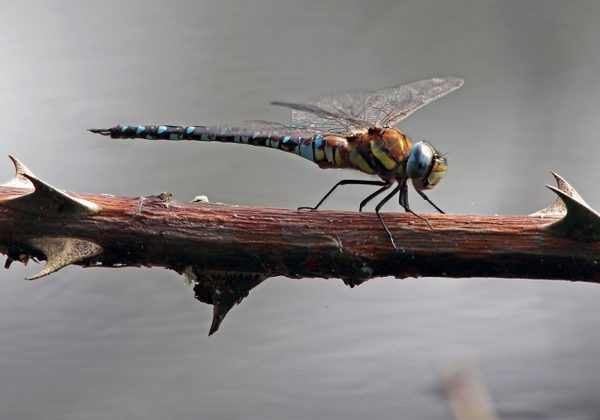
Emperor Dragonfly
Larger dragonflies
In contrast, the larger dragonflies, of which the commonest are the emperor (anax imperator), the ‘broad-bodied chaser’ (libellula depressa), the ‘southern hawker’ (aeshna cyanea) and the ‘brown hawker’ (aeshna grandis), live a mostly solitary existence. They are fiercely territorial, with individuals commanding a small pond or part of a larger one and driving off any potential rivals.
Visiting dragonflies
Visiting dragonflies include the ‘downy emerald’ (cordulia aenea,) and the magnificent ‘golden-ringed dragonfly’ (cordulegaster boltonii), the largest British species.
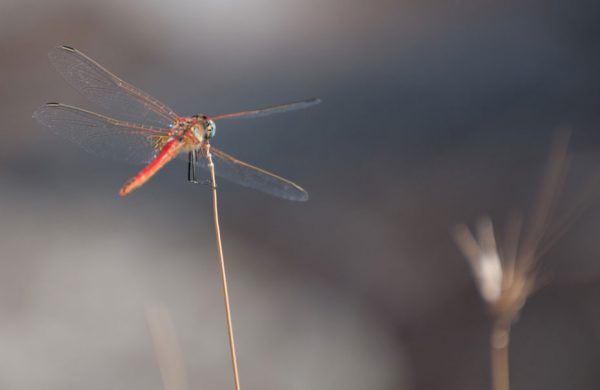
Large Red Damselfly
Damselflies
Regular breeding species on the ponds include the smaller damselflies (order: zygoptera), of which the most numerous are the distinctive ‘large red’ (pyrrhosoma nymphula), first to appear in spring, the ‘blue-tailed damselfly’ (ischnura elegans), and the ‘common blue’ (enallagma cyathigerum) and azure (coenagrion puella), which resemble each other very closely. The scarce ‘white-legged damselfly’ (platycnemis pennipes), creamy white in colour, is less often seen. Damselflies fly together, often in large numbers.
-
Flies
Of the 600,000 or so different species of insect, about 25 per cent of these species belong to the order of flies (diptera). Fly species are less visible although more numerous than the number of species of the order hymenoptera (bees, wasps and ants), which contribute about 20 per cent of the species.
Sawflies
Several species of sawflies (symphyta), are quite large and brightly coloured, and may be seen visiting flowers. Their name derives from the females’ saw-like ‘ovipositor’, part of the anatomy used to insert their eggs within plant tissues. Many sawflies have larvae which feed openly on leaves and resemble the caterpillars of moths and butterflies, but others develop inside galls (growths), which their food-providing plant or tree produces in response to the larva’s presence.
Gall wasps
Galls, which take unique forms according to the insect species that causes them, are also produced by the ‘gall wasps’ (cynipidae), also known as ‘gallflies’ and, in this case, they are much easier to identify than the minute insects themselves. Many ‘cynipid’ galls can be found on the Commons, including the familiar ‘oak-apple’ gall, the ‘marble’ and ‘spangle’ galls, also on oak, and the ‘robin’s pincushion’ gall on rose.
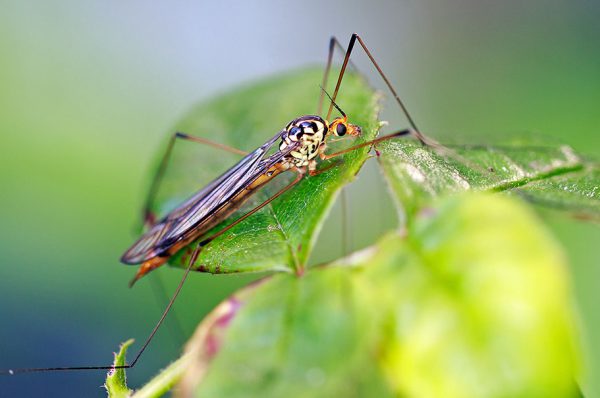
Ichneumon Wasp
Ichneumon wasps
Another important group of hymenoptera are the ‘ichneumon wasps’, whose larvae feed as parasites inside caterpillars or other insects. The females are generally armed with a conspicuous ovipositor, part of the anatomy used to insert their eggs, and some of the larger species are brightly patterned in yellow and black, or red and black. They are most often seen running about on sunlit foliage or flying around bushes and low vegetation in search of suitable hosts.
Hoverflies
Among the most prominent of the two-winged (one-pair) flies or ‘true fly’ (diptera) are the hoverflies, named for their aerial skills which allow them to hang motionless in mid-air. They are also effective mimics of bees and wasps. Young birds soon learn that insects patterned in yellow and black or red and black are either distasteful or capable of stinging, and many harmless insects gain protection by having a similar appearance. Around sixty species of hoverflies are to be found on the Commons, most of them visiting flowers along with their models.
Volucella (hoverflies)
The largest British species of hoverfly belong to the genus volucella. The impressive ‘hornet mimic hoverfly’ (volucella zonaria), a migrant species, has occasionally been recorded on the Commons. More likely to be seen is the ‘pellucid fly’ (volucella pellucens), which regularly hovers along woodland paths; its black and white colouration, unusual among hoverflies, is shared by the smaller spring-flying ‘leucozona lucorum’.
Wasp-patterned hoverflies
Many of the Commons’ hoverflies have variations on the standard wasp pattern of yellow and black stripes. These include the common ‘syrphus ribesii’, the distinctive ‘helophilus pendulus’ with vertical stripes on the thorax as well as the usual horizontal ones on the abdomen, and the latter’s larger and scarcer relative ‘helophilus trivittatus’.
Xylota (hoverflies)
The slender-bodied members of the hoverfly genus ‘xylota’ are to be seen on sunlit leaves rather than flowers: they include the red-banded ‘xylota segnis’ and the beautiful gold-banded ‘xylota sylvarum’.
Drone-flies (hoverflies)
The drone-flies, of which six species are found on the Commons, are bee mimics, and include the very common ‘eristalis tenax’, which is notable for hibernating as an adult and appearing on sunny days all through the year. This species and the similar ‘eristalis pertinax’ resemble honeybees, while ‘eristalis intricarius’ is a furry bumblebee mimic.
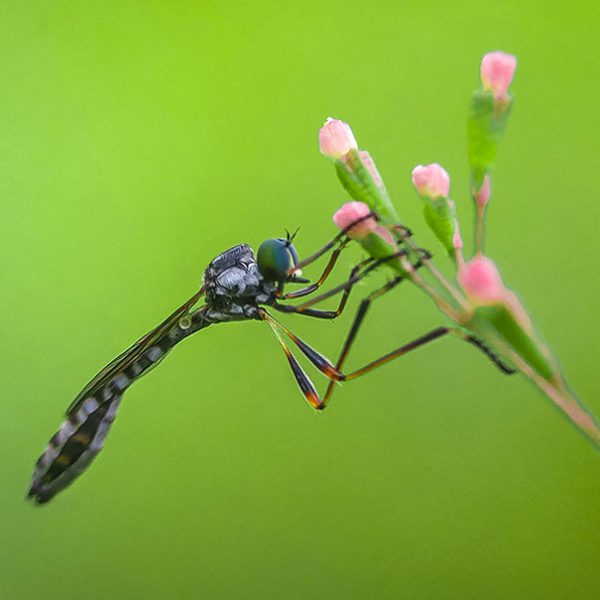
Robber Fly
Robber flies
Robber flies are a group of fierce predators which capture smaller insects with their spiny forelegs. A number, like the widespread ‘machimus atricapillus’, are characteristic of open areas where they perch on bare sand, rocks or low vegetation, waiting for suitable victims. Other forms, such as the shiny black ‘choerades marginata’ and ‘common awl robber fly’ (neoitamus cyanurus) with its metallic blue tail, are found in woodland areas and may be spotted on sunlit foliage beside footpaths.
Long-headed flies
Much smaller predators are the long-headed flies, often metallic green or silvery in colour, many of which are also to be seen on sunlit foliage or around the edges of ponds. The males of the most noticeable ‘semaphore fly’ (poecilobothrus nobilitatus), have white-tipped wings which are waved in its courtship display as large numbers of both sexes swarm over damp mud.
Soldier flies
Soldier flies are brightly coloured sun-loving insects, of which those found on the Commons include the ‘metallic green’ (chloromyia formosa) and the three-coloured ‘twin-spot centurion’ (sargus bipunctatus).
Bee flies
The ‘large bee fly’ (bombylius major), as its name suggests, resembles a brown bumblebee, and is frequently seen in spring exploring the nest sites of solitary bees, in which its larvae live as parasites, or hovering in front of flowers and probing them with its long rigid proboscis.
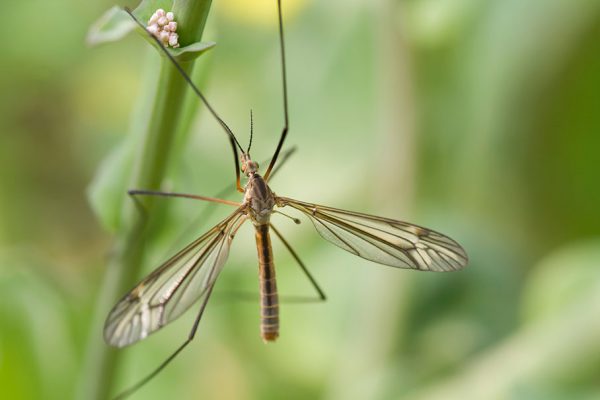
Marbled Winged Crane Fly
Crane fly
The largest member of the ‘true fly’ (diptera) found on the Commons is the impressive marbled-winged ‘crane fly’ (tipula maxima).
Crane flies, with their enormously long legs, are an easily recognized group of insects, and the familiar medium-sized forms, some patterned with yellow and black, are widespread in the grassy areas of the Commons, as is the shiny black ‘St Mark’s fly’ (bibio marci), named after its characteristic swarming flight in spring.
Tachinid flies
The flies of the family of ‘tachinid flies’ (tachinidae) spend their larval stage as internal parasites of other insects, usually caterpillars, but the bristly adults often feed openly at flowers, and some are brightly coloured. One of the most numerous species on the Commons is the red-spotted ‘eriothrix rufomaculata’ which can be found visiting ragwort. The beautifully metallic greenbottles (lucilia species pluralis) are among the most abundant of many ‘true fly’ (diptera) species, which rest in open view on sunlit foliage and tree trunks; others include the shiny black ‘noonday fly’ (mesembrina meridiana) with its bright yellow wing bases.
-
Grasshoppers & Crickets
Grasshoppers and crickets form a prominent part of the Commons’ insect fauna, particularly in high summer when the distinctive songs of several species can be heard throughout the areas of open grass and heathland. These songs are a means of communication between the sexes and can be recognized in the same way as bird song.
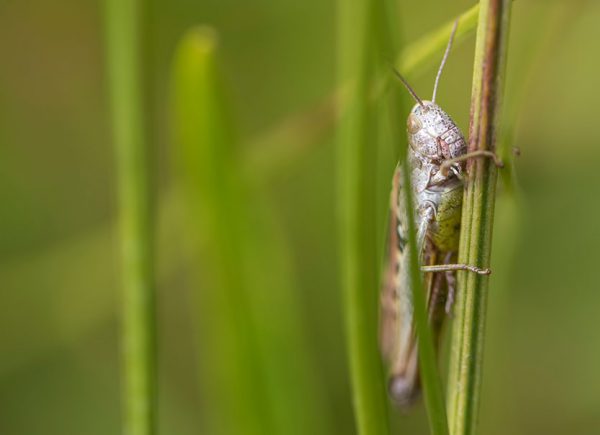
Common Green Grasshopper
Grasshoppers – with sound
Most of the sound to be heard in summer grassland emanates from the Commons’ three grasshopper species: the ‘common field grasshopper’ (chorthippus brunneus) and ‘common green grasshopper’ (omocestus viridulus), both of which are fully winged, and the ‘short-winged meadow grasshopper’ (chorthippus parallelus).
Cricket – with song
Of the bush-crickets, the only one with an audible song is the ‘long-winged conehead’ (conocephalus discolor), a former rarity which has only recently colonised the Tunbridge Wells area.
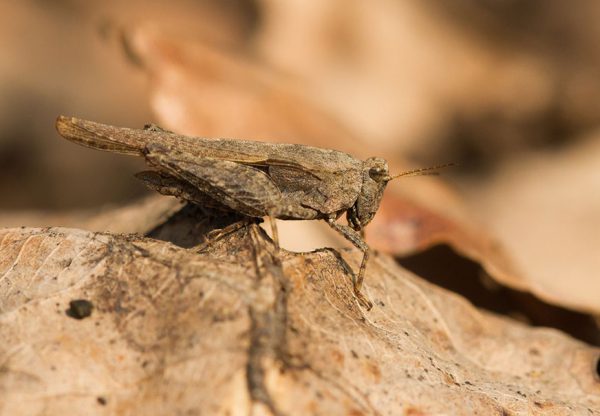
Slender Groundhopper
Crickets – ground dwelling
The ‘common ground-hopper’ (tetrix undulata) and ‘slender ground-hopper’ (tetrix subulata) are generally inconspicuous creatures that can sometimes be spotted in numbers on sparsely vegetated ground, often near water.
Crickets – inhabiting dense vegetation
The ‘dark bush-cricket’ (pholidoptera griseoaptera) and ‘speckled bush-cricket’ (leptophyes punctatissima) live in dense vegetation such as bramble thickets and may be spotted sitting on leaves.
Cricket – tree dwelling
The delicate pale green ‘oak bush-cricket’ (meconema thalassinum) spends its time high in the trees and is only occasionally seen at ground level, when for example it is blown down by the wind.
-
Molluscs
Molluscs are invertebrates and a major division of animal life, alongside arthropods (which include the many species of insects); and a significant element in the Commons’ fauna, both in the various ponds and on land. The most attractive of the terrestrial snails is the highly variable ‘white-lipped snail’ (cepaea hortensis), whose brightly coloured or banded shells are often seen in fragmentary form around the ‘anvils’ of the song thrush.
-
Spiders
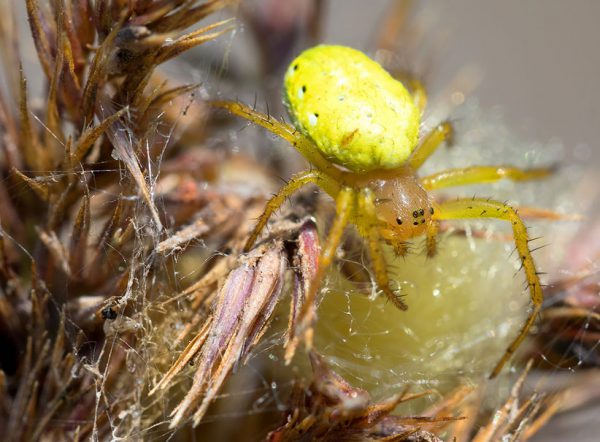
Cucumber Green Spider
Spiders belong to the chelicerates, division of arthropods (exoskeletal animals).
On the Commons, they are the most conspicuous of an invertebrate, representing a variety of lifestyles. Spiders are most popularly associated with the building of webs, the most elaborate being those constructed by the orb weavers such as the large and familiar ‘garden spider’ (araneus diadematus) or the smaller bright ‘cucumber green spider’ (araniella cucurbitina).
Many species, however, actively hunt their prey. These include the ‘jumping spiders’ (salticidae), often seen on sunlit rocks, the fast running ‘wolf spiders’ (lycosidae) which may be seen in large numbers on open ground, the females carrying their silken egg-sacks, and the impressive white-banded ‘nursery web spider’ (pisaura mirabilis), which is generally seen perched quite visibly on foliage. The white or yellow ‘flower crab spider’ (misumena vatia) sits on flowers, waiting to pounce on visiting insects.
-
Woodlice
Woodlice are crustaceans, but unlike most of its cousins is non aquatic. On the Commons they are represented by the ‘pill woodlouse’ (armadillidium vulgare), that defends itself by rolling into a ball.
-
Other insects
The ponds on the Commons also support various species of mayflies (ephemeroptera), stoneflies (plecoptera) and caddisflies (trichoptera). The larvae of the latter are well-known for the protective cases they construct out of plant material or other debris gathered from their watery habitat, but the adults, if noticed at all, are likely to be mistaken for moths. These three groups are among the smaller insect orders, as are the lacewings (chrysopidae – of the order neuroptera), which eat aphids in both adult and larval stages. Those most likely to be noted on the Commons are the delicate green species of the lacewing genus chrysopa (of the family chrysopidae). A related group are the ‘scorpion-flies’ (mecoptera) often seen fluttering among brambles or nettles. Despite the curious scorpion-like tail of the male, they are harmless scavengers.
-
Bees, Wasp & Ants
-
Mammals
A full list of mammals has yet to be compiled, but several species occur in addition to the substantial populations of ‘grey squirrels’ (sciurus carolinensis) and rabbits (oryctolagus cuniculus).
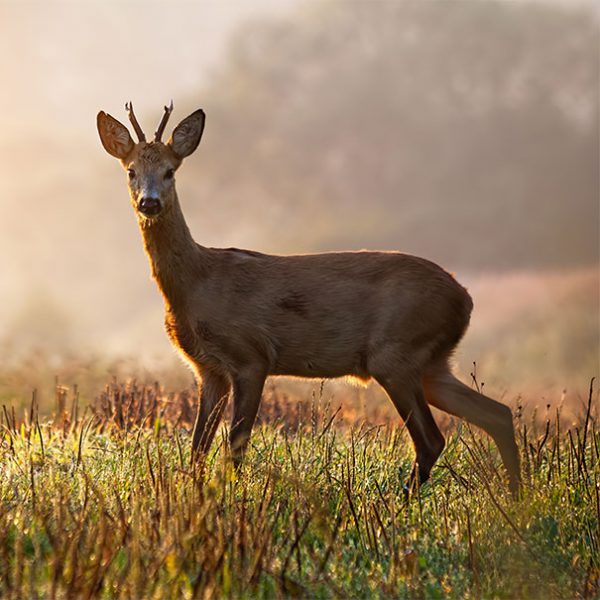
Roe Deer
Larger mammals
Foxes (vulpes vulpes) are often to be seen, even in daylight, while badgers (meles meles) forage on the Commons at night from sets situated around the perimeter.
Small deer (capreolus capreolus) undoubtedly occur on both Commons, although it is unclear whether they are a permanent feature or occasional visitors from the contiguous open countryside. Roe Deer have been seen on Rusthall Common, and there is some evidence for the introduced muntjac.
Lyme Disease
Be aware that the presence of deer means there is a possibility of being infected by tick-borne Lyme Disease. Please go to the doctor if you develop a ‘bull’s eye’ rash (a circular expanding rash with target-like appearance). This disease is easily treated in its early stages but can be serious and uncurable if left untreated.
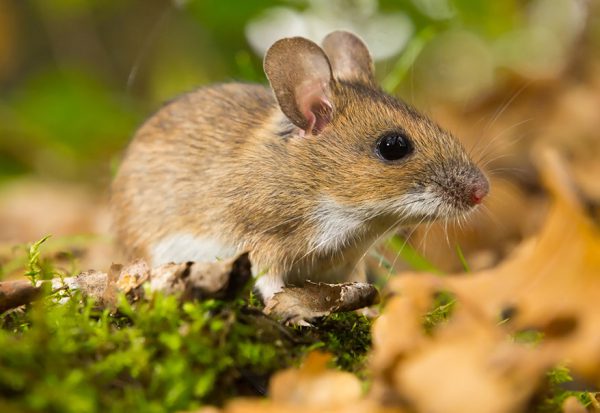
Yellow Necked Mouse
Smaller mammals
Mole (talpa europaea) hills are a familiar feature of some grassy areas such as that near Brighton Lake, and hedgehogs (erinaceus europaeus) are also resident. Weasels (mustela nivalis) have been recorded on Tunbridge Wells Common, and a common dormouse (muscardinus avellanarius) near Toad Rock.
The areas of acid grassland with their tussocks and anthills are ideal for small rodents to feed while keeping themselves hidden from predators: voles (microtus agrestis), mice (yellow necked – apodemus flavicollis) and shrews (common – sorex araneus) all occur, although particular species have not been identified.
In the evening bats may be seen, mostly the ‘common pipistrelle’ (pipistrellus pipistrellus), a small and very common species, although the larger noctule has also been reported.
-
Reptiles & Amphibians
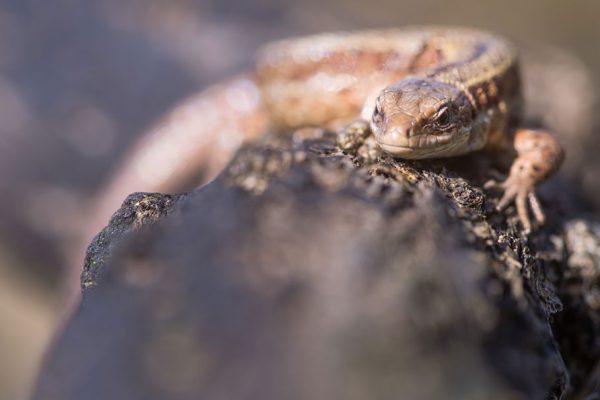
Common Lizard
Reptiles
The heathland environment of the Commons, along with their various ponds, have historically supported a variety of reptiles. Despite the more recent decline of heathland, species such as the ‘common lizard’ (zootoca vivipara) have managed to survive in more open areas.
Lizards are seen quite regularly sunning themselves on anthills or similar exposed locations, although they are easily disturbed and rapidly vanish out of sight among the grass. They are most likely to be spotted in the grassland near Highbury or along Mount Ephraim.
The ‘slow worm’ (anguis fragilis), a legless lizard, has also been recorded, but is very elusive. Another conspicuous reptile is the ‘grass snake’ (natrix helvetica), which is most often seen near water. It can swim very effectively and is regularly seen doing so in Brighton Lake.
The adder (vipera berus), a characteristic heathland species, is much less likely to be observed.
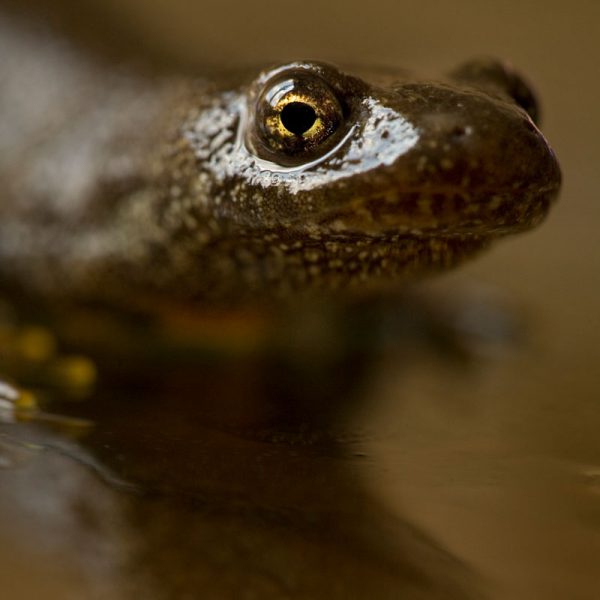
Great Crested Newt
Amphibians
The most widespread and abundant amphibians are the ‘common frog’ (rana temporaria) and ‘common toad’ (bufo bufo), which breed prolifically in all the ponds on both Commons. The adults may be seen quite some distance from water.
The three British species of newts are also found breeding in ponds on the Commons, although the rarer ‘great crested’ (triturus cristatus) is encountered less frequently than the ‘smooth newt’ (lissotriton vulgaris) and ‘palmate newt’ (lissotriton helveticus).
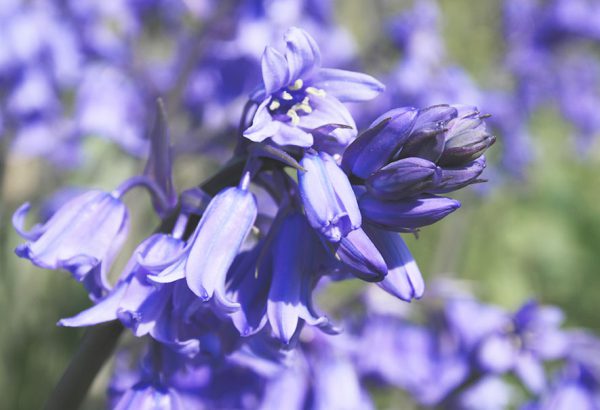
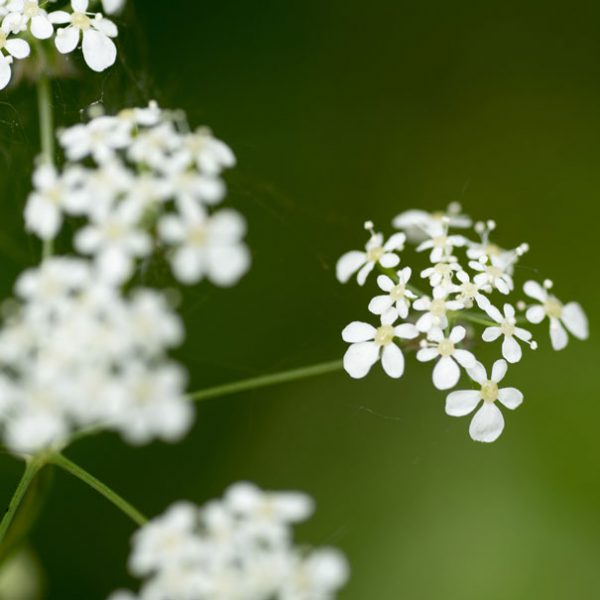
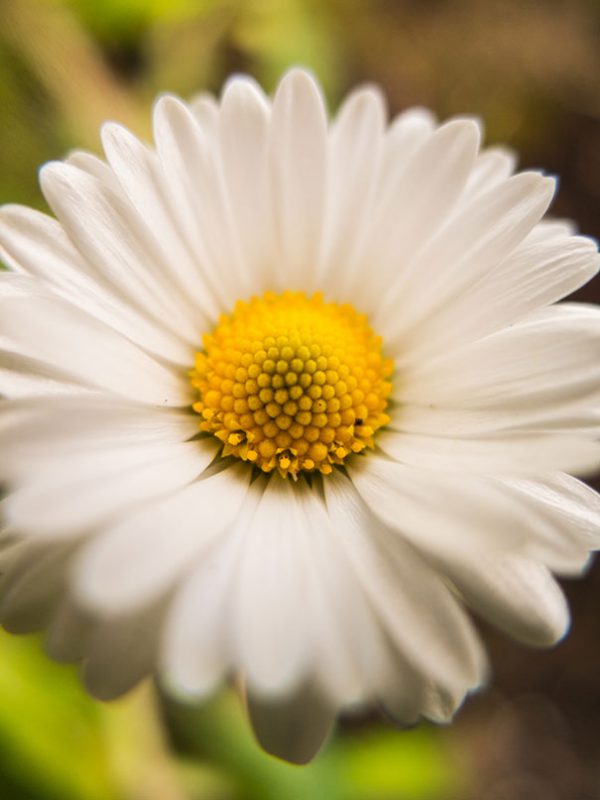
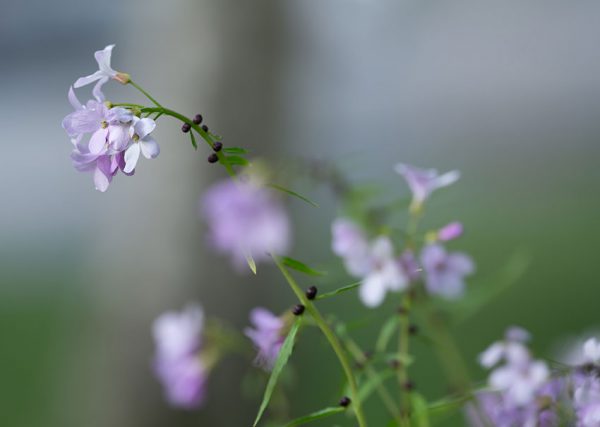
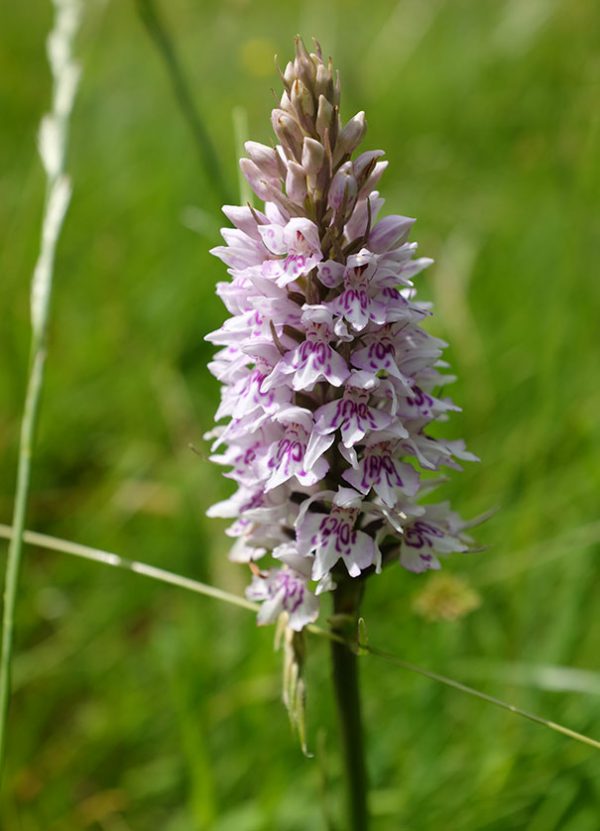
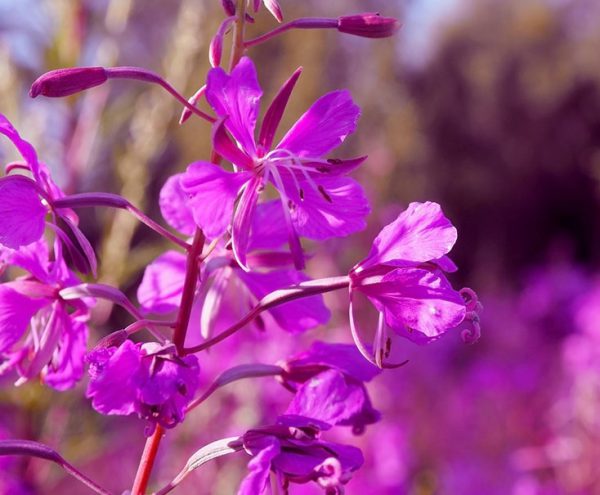
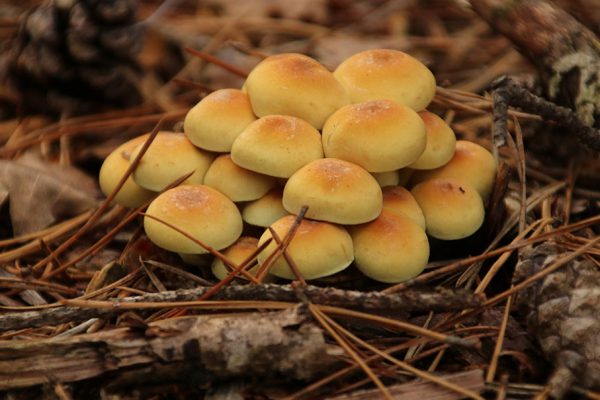
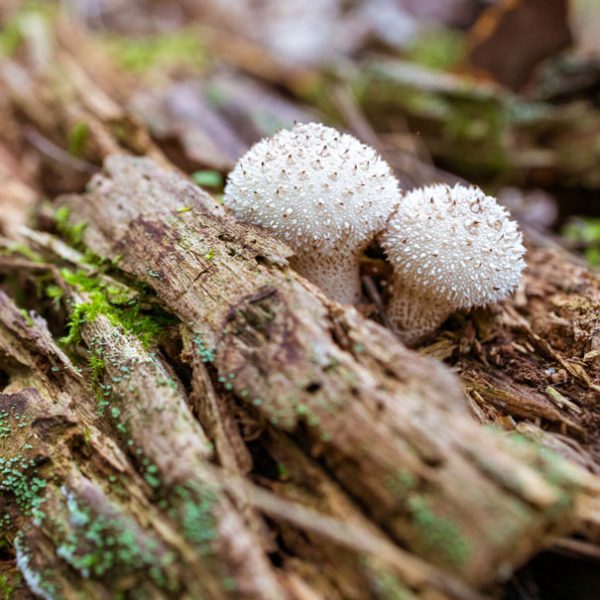 Puffball
Puffball